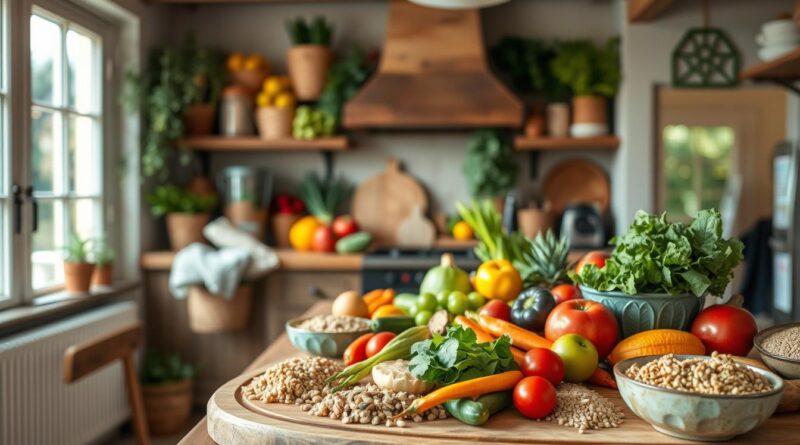How to Eat Healthy on a Budget: Smart Strategies to Save
Eating well can be tough, especially when money is tight. Many of us find it hard to balance our healthy lifestyle with tight budgets. But, the truth is, budget-friendly healthy eating is possible with a little planning and creativity.
With smart strategies, you can enjoy healthy meals without breaking the bank. This guide will show you how to plan meals, shop for groceries, and cook in ways that are both healthy and affordable. Whether you’re a busy worker or a parent wanting to feed your family well, you’ll discover ways to save and eat well.
Key Takeaways
- Plan your meals in advance to reduce food waste and save money.
- Shop smart by buying in bulk and choosing seasonal produce.
- Use cooking methods that preserve nutrients and reduce energy costs.
- Explore affordable protein sources and healthy alternatives.
- Make the most of leftovers to minimize waste.
The Challenge of Balancing Nutrition and Cost
Many people find it hard to eat healthy because it seems too expensive. But, it doesn’t have to be. By understanding the challenges and myths of eating healthy on a budget, you can make better food choices.
Common Misconceptions About Healthy Eating Costs
Some think healthy food means buying fancy or rare items. But, affordable healthy meal planning uses simple ingredients. Foods like beans, grains, and fresh veggies are both healthy and cheap.
The Real Cost of Poor Nutrition
Poor eating can cause serious health problems, leading to high medical bills. Choosing healthy food can save money in the long run. Tips for eating healthy on a budget often include planning and smart shopping to avoid health issues.
Setting Realistic Food Budget Goals
To eat healthier without spending too much, start by setting achievable goals. Look at how much you spend now, plan your meals, and shop wisely. This way, you can enjoy healthy meals without breaking the bank.
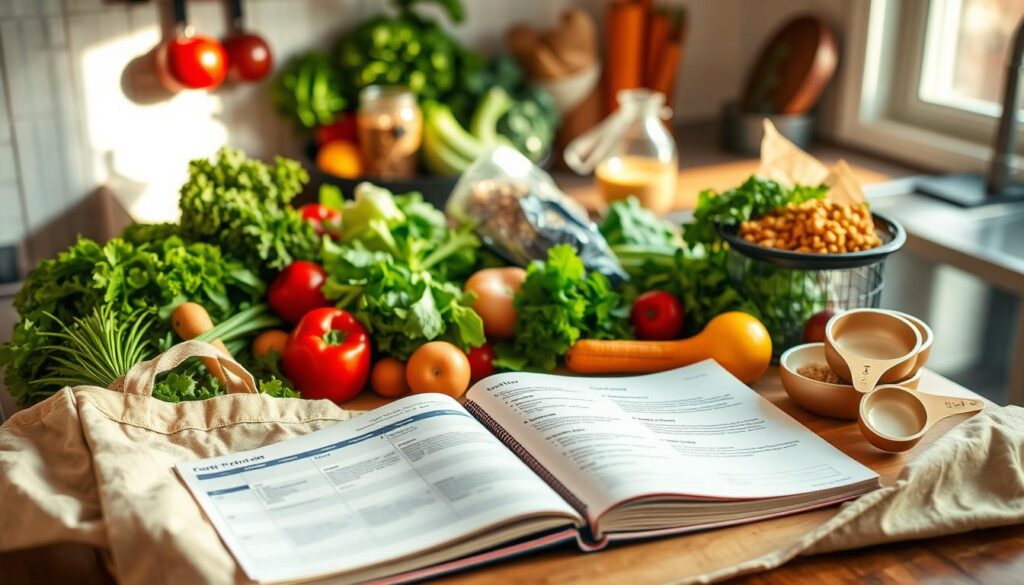
How to Eat Healthy on a Budget: The Fundamentals
Eating healthy doesn’t have to cost a lot if you know the basics. To eat nutritious meals without spending too much, you need to plan and understand what’s affordable. This means knowing what foods are both healthy and cheap.
Nutritional Priorities When Money Is Tight
When money is tight, focus on the most important nutrients. Choose foods like beans, lentils, and whole grains. They are full of nutrients and don’t cost a lot.
The 80/20 Approach to Affordable Healthy Eating
The 80/20 rule is great for eating healthy on a budget. It means eating healthy 80% of the time and allowing for some flexibility. This way, you can enjoy a balanced diet without feeling too limited.
Calculating Cost Per Nutrient vs. Cost Per Calorie
It’s important to know the difference between cost per nutrient and cost per calorie. Foods that are high in nutrients but low in calories can be more cost-effective. This can help you save money in the long run.
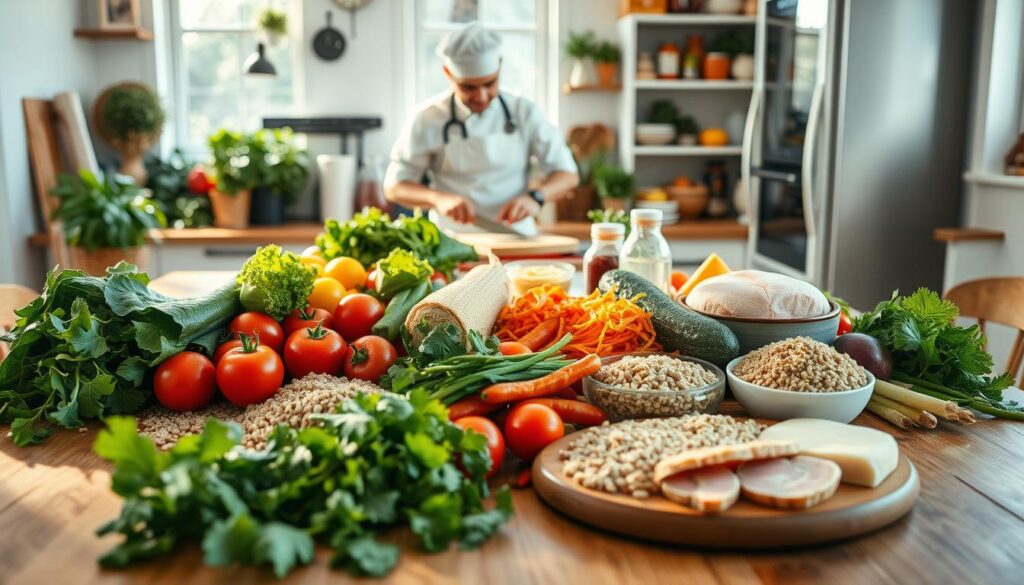
| Food Item | Cost Per Serving | Nutrient Density |
|---|---|---|
| Oats | $0.50 | High in Fiber |
| Lentils | $0.75 | Rich in Protein and Fiber |
| Quinoa | $1.00 | Complete Protein, High in Minerals |
Strategic Meal Planning for Maximum Savings
Planning meals wisely can help you save money on food. By matching meals with weekly sales and using leftovers, you can cut down on grocery costs. This way, you can still eat healthy without spending too much.
Creating Weekly Meal Plans Based on Sales
First, look at the weekly ads for your local stores to find items on sale. Plan your meals around these sales, especially for things like fruits and meats that spoil quickly.
Template for a Budget-Friendly Meal Plan
Using a simple meal plan template can organize your meals for the week. A good plan includes:
- Breakfast options like oatmeal or scrambled eggs
- Lunch ideas such as salads or whole grain wraps
- Dinner plans including slow cooker meals or one-pot dishes
- Snacks like fruits, nuts, or carrot sticks with hummus
Incorporating Leftovers Strategically
Leftovers are a great way to save money and reduce waste. You can turn last night’s dinner into tomorrow’s lunch or add leftover veggies to a soup or stew.
Batch Cooking Methods That Save Time and Money
Batch cooking means making a lot of one ingredient or meal at once. This can save time and money by reducing waste and lowering the cost per meal.
For example, making a big batch of rice, grains, or beans can be used for many meals. Roasting a big chicken can give you leftovers for sandwiches, salads, or soups.
Reducing Food Waste Through Smart Planning
Smart meal planning can cut down on food waste. By planning meals and making a grocery list, you can avoid buying too much. Being creative with leftovers can also help reduce waste.
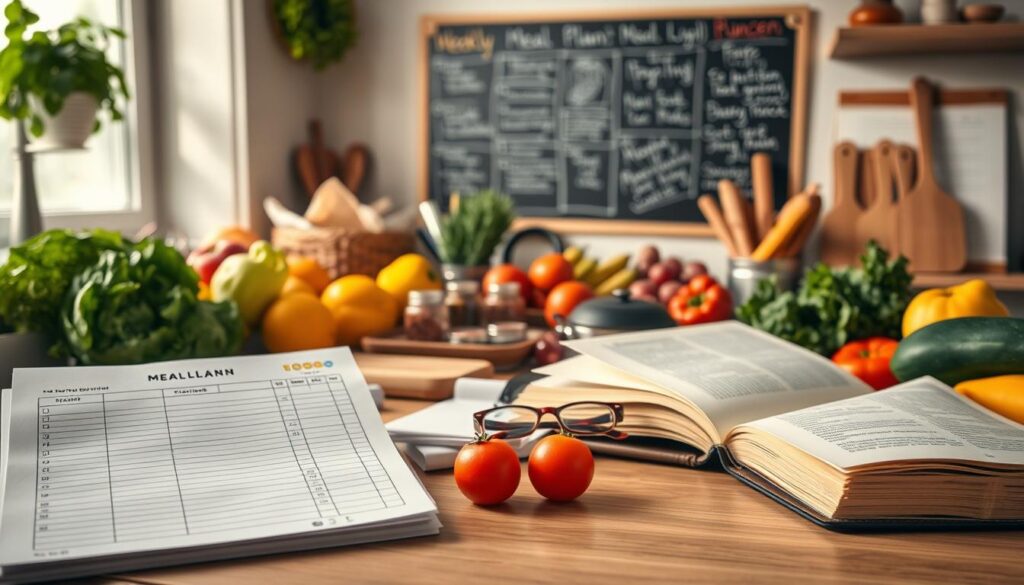
By using these meal planning strategies, you can enjoy low-cost healthy recipes and save money. Good meal planning is key to eating well on a budget. It helps you eat healthy without spending a lot.
Smart Grocery Shopping Tactics
To eat healthy without spending too much, learning smart grocery shopping is key. It’s not just about picking fresh produce. It’s about making choices that fit your budget and health needs.
Pre-Shopping Preparation
Before you go to the store, get ready. Make a shopping list and plan meals with store circulars. This way, you get the best deals.
Making and Sticking to Shopping Lists
Having a shopping list keeps you on track. It helps avoid impulse buys. Sticking to your list saves money.
Meal Planning Around Store Circulars
Store circulars show weekly deals. Plan meals with these items to save money. You’ll also get fresh, seasonal produce.
In-Store Strategies
In the store, there are ways to save. Compare prices and know the store layout to find deals.
Comparing Unit Prices Effectively
Unit prices let you compare different products. This helps choose the best value.
Navigating Store Layouts for Better Deals
Stores put expensive items at eye level. Look for deals on lower or higher shelves to save.
Best Days and Times to Shop for Deals
Shopping at the right time can save money. Many stores offer discounts on certain days or times.
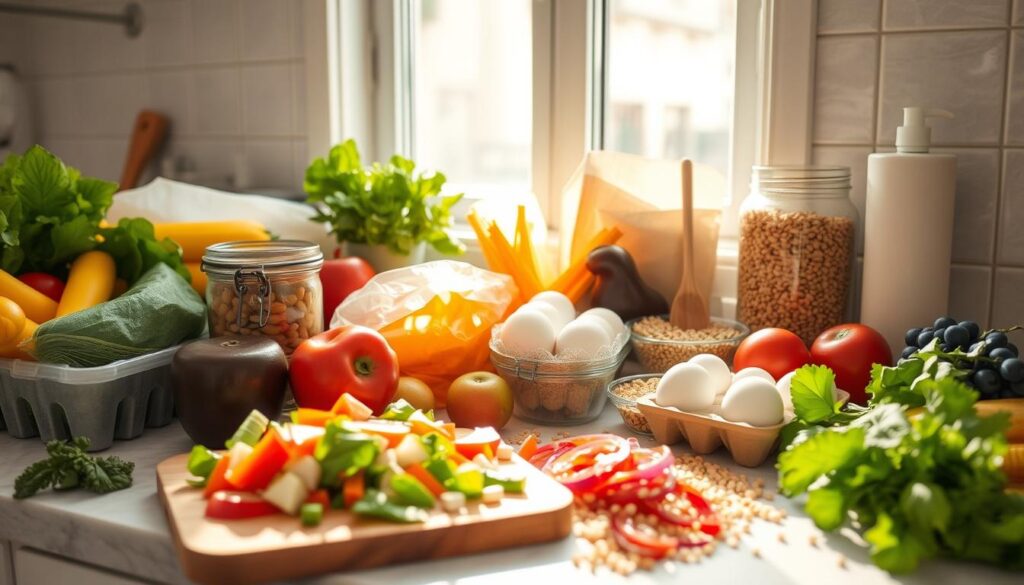
Using these smart shopping tactics, you can eat healthy and save money. It’s easy to do without spending a lot.
Seasonal Eating: Better Taste, Lower Cost
As the seasons change, you can eat healthier and save money by picking seasonal produce. Seasonal eating is a smart way to plan affordable healthy meals. It lets you enjoy fresh tastes and cut down on grocery bills.
Understanding Seasonal Produce Cycles in the US
The United States has a wide range of climates. This means the types of seasonal produce available changes a lot from place to place. Knowing what’s in season in your area helps you make better choices at the grocery store.
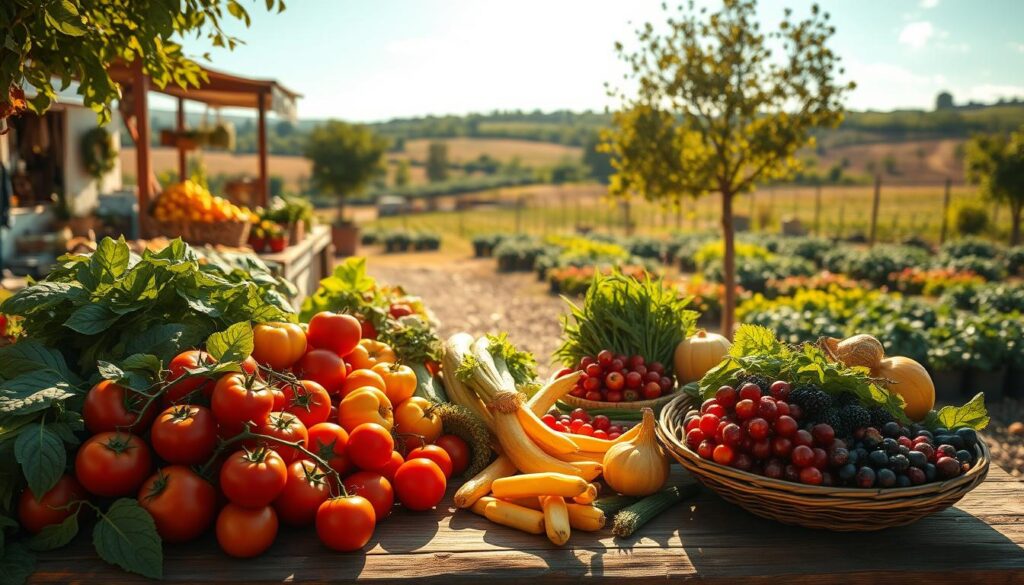
Building Meals Around Seasonal Ingredients
To get the most from seasonal eating, focus on using what’s available. This approach ensures your food is fresh and helps you eat nutritious meals on a budget. Here are some tips:
- Check local farmers’ markets or grocery stores for seasonal produce.
- Plan your meals around the freshest ingredients available.
- Get creative with recipes that incorporate seasonal vegetables and fruits.
Preserving Seasonal Bounty for Year-Round Savings
Preserving seasonal produce is a smart way to enjoy your favorite foods all year while saving money. Freezing and canning are two effective methods.
Freezing Techniques
Freezing is a simple way to keep seasonal produce fresh. Blanching vegetables before freezing helps keep their color and nutrients.
Simple Canning Methods
Canning is another great way to preserve seasonal produce. It’s easy to learn and you can do it with basic kitchen tools.
| Produce | Peak Season | Preservation Method |
|---|---|---|
| Strawberries | Spring | Freezing, Jam-making |
| Tomatoes | Summer | Canning, Freezing |
| Apples | Fall | Freezing, Dehydrating |
By embracing seasonal eating and preservation, you can enjoy a varied and nutritious diet. And you’ll keep your food costs down.
Affordable Protein Sources for a Balanced Diet
You don’t have to spend a lot to get enough protein. Adding affordable protein sources to your diet can keep it balanced without costing too much.
Plant-Based Protein Options
Plant-based proteins are good for your health and your wallet. Two great choices are:
Beans, Lentils, and Legumes
These are packed with protein, fiber, and vitamins. They’re flexible and can be used in many dishes, from soups to salads. Buying them in bulk can save you a lot of money.
Tofu and Tempeh
These soy products are great for protein and are affordable, especially in bulk. They can be marinated and cooked in many ways, adding variety to your meals.
Budget-Friendly Animal Proteins
There are also affordable animal protein options.
Less Expensive Cuts of Meat
Cuts like chuck roast or chicken thighs are cheaper and full of flavor. Slow cooking makes them tender and tasty.
Eggs and Dairy
Eggs are a cheap but protein-rich food. Dairy like milk and yogurt are also affordable protein sources.
Protein Portion Control for Savings
Knowing the right protein portion sizes can save you money. A serving size is about the size of your palm. Being aware of this helps avoid overbuying and waste.
Bulk Buying and Food Storage Strategies
Buying in bulk and storing food well are key to eating healthy on a budget. By getting pantry staples in bulk and storing them right, you can cut down your grocery costs a lot.
Pantry Staples Worth Buying in Bulk
Non-perishable items like rice, beans, and canned goods are great for bulk buying. These are essential for many low-cost healthy recipes and keep well for a long time.
- Rice and other grains
- Canned vegetables and beans
- Nuts and dried fruits
When Bulk Buying Doesn’t Save Money
But, buying in bulk isn’t always smart. Don’t get perishable items or things that might spoil in bulk. Think about how much you’ll use and how you’ll store it before buying a lot.
Storage Solutions to Extend Food Freshness
Keeping your food fresh is all about good storage. Proper pantry organization and refrigerator and freezer management are crucial.
Pantry Organization
Organizing your pantry means sorting items, using airtight containers, and making sure you can easily find what you need.
Refrigerator and Freezer Management
Managing your fridge and freezer right means keeping the right temperatures, using airtight containers, and getting rid of expired or bad food regularly.
| Item | Bulk Buying Benefit | Storage Tip |
|---|---|---|
| Rice | Saves up to 30% on cost | Store in airtight containers |
| Canned Goods | Long shelf life | Keep in a cool, dry place |
| Nuts and Dried Fruits | Convenient for snacking | Store in sealed bags or containers |
Budget-Friendly Healthy Snacks and Beverages
You don’t have to spend a lot to enjoy healthy snacks and drinks. With a bit of planning, you can find nutritious options that won’t empty your wallet.
Homemade Snack Ideas Under $1 Per Serving
Homemade snacks are both affordable and healthy. Here are some ideas:
- Oatmeal raisin cookies made with rolled oats and dried fruits
- Trail mix with nuts, seeds, and dried fruits
- Homemade popcorn seasoned with herbs and spices
These snacks are under $1 each and full of nutrients. For example, oatmeal raisin cookies give you lasting energy. Trail mix is a great mix of proteins and healthy fats.
Affordable Alternatives to Expensive Packaged Snacks
Many packaged snacks are pricey and unhealthy. Here are some cheaper options:
- Replace energy bars with homemade granola bars
- Choose whole fruits instead of fruit cups
- Opt for air-popped popcorn instead of pre-packaged chips
By making these simple changes, you can save money and eat better.
Hydration Options Beyond Bottled Beverages
Staying hydrated doesn’t have to mean buying expensive bottled water or sugary drinks. Here are some alternatives:
- Tap water with slices of lemon or lime
- Infused water with fruits or herbs
- Unsweetened tea or coffee
These choices are not only budget-friendly but also better for the planet.
By following these tips, you’ll be on your way to eating healthy without spending a lot. The key is to plan ahead and make smart choices.
Growing Your Own Food: From Windowsill to Table
Growing your own herbs and vegetables is a cost-effective approach to healthy eating. Starting small lets you enjoy fresh produce at home. This reduces your need for expensive grocery store items.
Easy Herbs and Vegetables for Beginners
For beginners, starting with easy plants is key. Herbs like basil, mint, and cilantro are simple to grow. They add fresh flavor to meals. Tomatoes, lettuce, and radishes are also easy, needing little care and growing fast.
Container Gardening for Small Spaces
Even without a big backyard, you can still grow food. Container gardening is perfect for small areas. It lets you grow plants on balconies, patios, or windowsills. Make sure your containers are at least 5-7 gallons for most veggies.
Cost-Benefit Analysis of Home Gardening
Setting up a garden costs money upfront, but saves a lot in the long run. Growing your own food cuts down grocery bills. Plus, you get fresh, healthy produce right at home.
Initial Investment vs. Long-Term Savings
The first cost of seeds, containers, and soil varies. But it’s a one-time expense that saves money later. For instance, a packet of seeds costs about $2. Store-bought fresh herbs can cost $3-$4.
Time Investment Considerations
Gardening takes time, but even a few minutes daily helps. The effort spent on your garden is rewarding and calming.
Adding home gardening to your life means a cost-effective healthy diet. You’ll also enjoy the pride of eating food you’ve grown yourself.
Budget-Friendly Cooking Methods and Equipment
Budget-friendly cooking means being efficient and choosing the right tools. By picking the best cooking methods and kitchen tools, you can cut down on food and energy costs.
One-Pot Meals for Efficiency
One-pot meals save time, energy, and money. They need fewer pots and pans, which means less cleanup and energy use. Think of stews, pasta dishes, and stir-fries.
Energy-Efficient Cooking Techniques
Choosing the right cooking techniques saves energy. For example, using a pot lid keeps heat in, shortening cooking time. Pressure cookers also use less energy.
Essential Kitchen Tools That Save Money Long-Term
Buying the right kitchen tools saves money over time. Multi-purpose equipment like slow cookers or Instant Pots can replace many single-use appliances.
Multi-Purpose Equipment Worth the Investment
- Slow Cooker
- Instant Pot
- Cast Iron Skillet
Items to Skip or Find Second-Hand
- Avoid single-use gadgets
- Consider thrift stores or online marketplaces for second-hand kitchenware
| Equipment | Cost | Energy Savings |
|---|---|---|
| Slow Cooker | $50 | High |
| Instant Pot | $100 | Very High |
| Cast Iron Skillet | $20 | Medium |
Navigating Food Assistance Programs and Community Resources
Exploring food assistance programs can greatly help those with limited budgets. Many community resources are ready to offer support. They help make healthy food more affordable.
SNAP Benefits and Farmers Market Programs
SNAP (Supplemental Nutrition Assistance Program) benefits help buy healthy groceries. Now, many farmers’ markets accept SNAP. This lets people get fresh, local produce.
Some programs even give matching funds for SNAP at farmers’ markets. This doubles the value of the benefits.
Food Banks and Community Gardens
Food banks give out essential groceries to those in need. Community gardens let people grow their own food. These are key for a budget-friendly, healthy diet.
Cooperative Buying Groups and CSAs
Cooperative buying groups and Community Supported Agriculture (CSA) programs offer fresh, local produce at lower prices. They make eating healthy more affordable and accessible.
Conclusion: Sustainable Healthy Eating on Any Budget
Eating healthy on a budget is not just a dream. It’s something you can do with the right strategies. By planning meals, shopping smart, and cooking wisely, you can eat well without spending too much.
Creating a cost-effective healthy diet means being consistent and flexible. You’ve learned how to adjust to fit your budget and needs. Every choice, from seasonal produce to affordable proteins, helps you live a budget-friendly healthy eating lifestyle.
By choosing wisely and watching your food budget, you can have a balanced diet. Begin your journey to healthy eating on a budget today. Discover the good things about planning your nutrition well.

